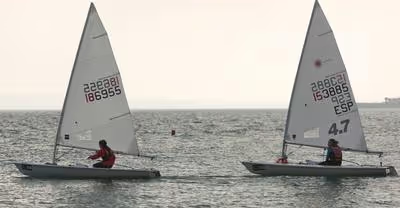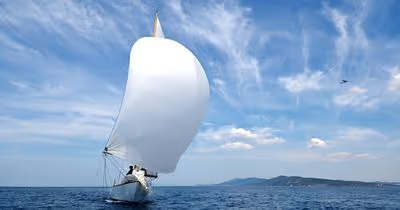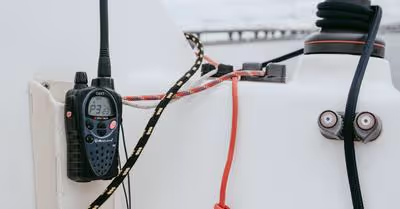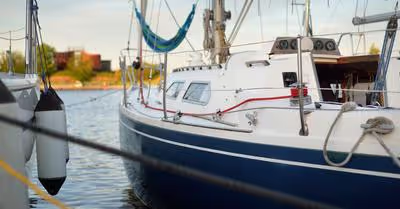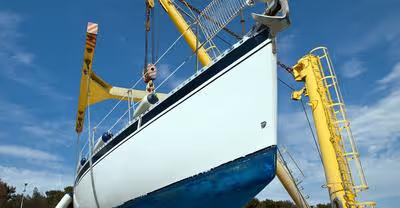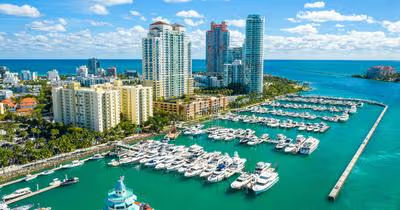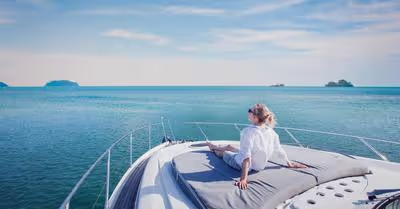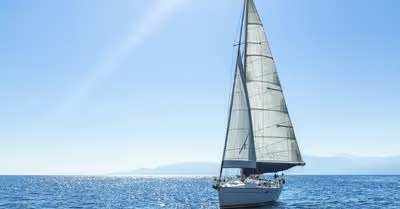Table of Contents
Sailing terms involving maneuvering the sailboat
These are terms we use to describe actions we take with the sailboat or actions that occur as a result of getting from point A to point B. Knowing these terms is great if you’re joining a crew or need to describe specific things to your skipper or other sailors.
Tacking
Turning the boat through the wind so that the wind changes from one side to the other
Lee
the direction toward which the wind is blowing. When sailing close to the wind, this is the direction you want to go.
Jibe
changing tacks through the wind so that both sides of your boat are exposed to it
Luffing
when your sails lose power and the boat starts to lose speed because the sails are not filling with wind.
Trim
The trim of a boat is how balanced it is. The sails and other components can be adjusted to help keep the boat in trim.
Weather helm
when a sailing vessel tends to turn into the wind as a result of excessive wind.
Capsize
The act of flipping a sailboat over.
Sail Trim
Sail trim is the way that the sails are adjusted so that they catch as much wind as possible.
Sailing terms specific to the Anatomy of a Sailboat
These describe the sailboat itself. These are helpful for pinpointing specific issues with parts of the boat, looking for replacement parts or for calling out commands while out sailing. This is by far the longest section in this article as there are so many parts and items to describe!
Bow
The bow is the front end of a boat. It's also the part that cuts through the waves and displaces the most water.
Port
left side of a sailing vessel when facing forward
Starboard
right side of a sailing vessel when facing forward
Helm
the tiller, or control of the rudder on a boat
Rudder
The rudder is a large, hinged blade that's located at the back of a boat. It's used to steer the boat in the desired direction.
Cuddy cabin
a small cabin in a boat that's used for storage or sleeping
Mainsail
the mainsail on a boat. Most modern boats have a bermuda sail as a common rig.
Staysail
a triangular sail set forward of the mainsail, used to support a mast as well.
Jib
a triangular sail, usually set at the front of a boat, that is used to help control the boat's direction. Helps the boat sail closer to the wind.
Spinnaker
the large sail that is set on downwind points of sail, used for racing.
Asymmetrical spinnaker
the spinnaker only has one side with fabric to gather wind, rather than both sides. This allows for better performance in lighter winds.
Trisail
a triangular sail that is set above the mainsail, used to increase performance in high winds.
Cockpit
the area of the boat where the helmsman and crew sit
Foil
a thin metal or plastic plate on the bottom of a boat's hull that helps it move faster through the water by reducing drag
Keel
a large fin that is attached to the bottom of a boat's hull, and helps keep it from tipping over
Drogue
a large parachute-like device that is towed behind a boat to slow it down in heavy seas
Bilge
The bilge is the lowest compartment in a ship or boat, and it's usually very close to the water level. If a boat fills with water, it is because of cargo leakage from bad storage planning or design.
Boom
A boom is a spar, or long, thin piece of timber that helps to extend the sails. It's attached at one end to the mast and at the other end to a fore-and-aft sail.
Clew
The corner where the leech and foot connect on a fore-and-aft sail.
Keel
The keel is a long, thin and deep strip of metal or wood that goes along the bottom of a boat. It provides stability and helps the boat move through the water more easily.
Mast
The mast is a long, vertical pole that holds the sails and connects to the top of the cabin or hull. It's usually made of metal or wood.
Sail
A sail is a piece of fabric that's used to catch the wind and power a boat.
Stern
The stern is the back end of a boat, and it's also another name for a rudder.
Tack
Not to be confused with tacking as a maneuver. The tack is the front lower corner of a sail. This is the side that's closest to the boat when the sail is full.
Trim
The trim of a boat is how balanced it is. The sails and other components can be adjusted to help keep the boat in trim.
Head
A head is the part of a boat where toilets are usually located.
Yard
A yard is another name for a spar, or long, thin piece of timber that helps to extend the sails. It's attached at one end to the mast and at the other end to a fore-and-aft sail.
Windward
This term refers to the direction that the wind is blowing from. The opposite of windward would be leeward.
Leeward
This term refers to the direction that the wind is not blowing from. The opposite of leeward would be windward.
Galley
A galley is the kitchen area on a boat.
Berth
A berth is a bed or sleeping area on a boat.
Sextant
A sextant is an instrument that's used to measure angles in order to calculate latitude and longitude.
Draft
The draft of a boat is how deep it sits in the water. The higher the number, the deeper the boat's draft.
Plug
A plug is an object that's used to cover holes on a boat. They're usually made of metal or wood, and they need to be able to create a tight seal so that water cannot leak into the boat.
Cargo
Cargo is anything that's being transported on a boat, whether it's supplies, or vehicles.
Bilge
The bilge is the lowest part of the interior of a boat. It's where water and other liquids tend to collect.
Batten
Battens are thin pieces of wood or metal that are used to keep sails in shape. They're also known as leech sticks.
Boom
The boom is a long, horizontal pole that's used to extend the sails. It's attached at one end to the mast and at the other end to a fore-and-aft sail.
Crow's Nest
A crow's nest is a small platform that's typically located near the top of a mast. It's often used to hold one or more lookouts. Also mostly used in antiquity.
Deck
A deck is an enclosed bottom floor of a boat.
Hatch
This refers to any opening on the exterior of a boat that allows access inside, whether it's for passengers or supplies.
Outboards
This is a term used for engines that are on the outside of a boat, between the transom and the bow.
Inboards
This is a term used for engines that are on the inside of a boat, between the bow and the transom.
Ballast
A large, weighted beam that runs down the center of a boat. It provides stability and helps the boat move through the water more easily.
Locations specific to sailing
Some of these may seem obvious, but they’re useful for figuring out what’s what when you’re out on the water. Learning these will allow you to be specific about where you’re headed and where you’ve been!
Port
A port is a location along the side of a boat where supplies are stored or crew members walk in order to access their areas below deck.
Bluewater
The point at which land is no longer visible while at sea. Bluewater cruisers are well built and designed for extended trips out in the open ocean.
Units of Measurement
These will help you provide accurate information about your adventures or help determine weather conditions more accurately.
Knots
Knots are a unit of speed that's used when sailing. One knot is equal to one nautical mile per hour.
Fathom
A fathom is an old unit of measurement that is equal to six feet. It's used mainly for water depth measurements.
Pound
This refers to one pound force per square foot, which is a measure of pressure.
Recent Articles



